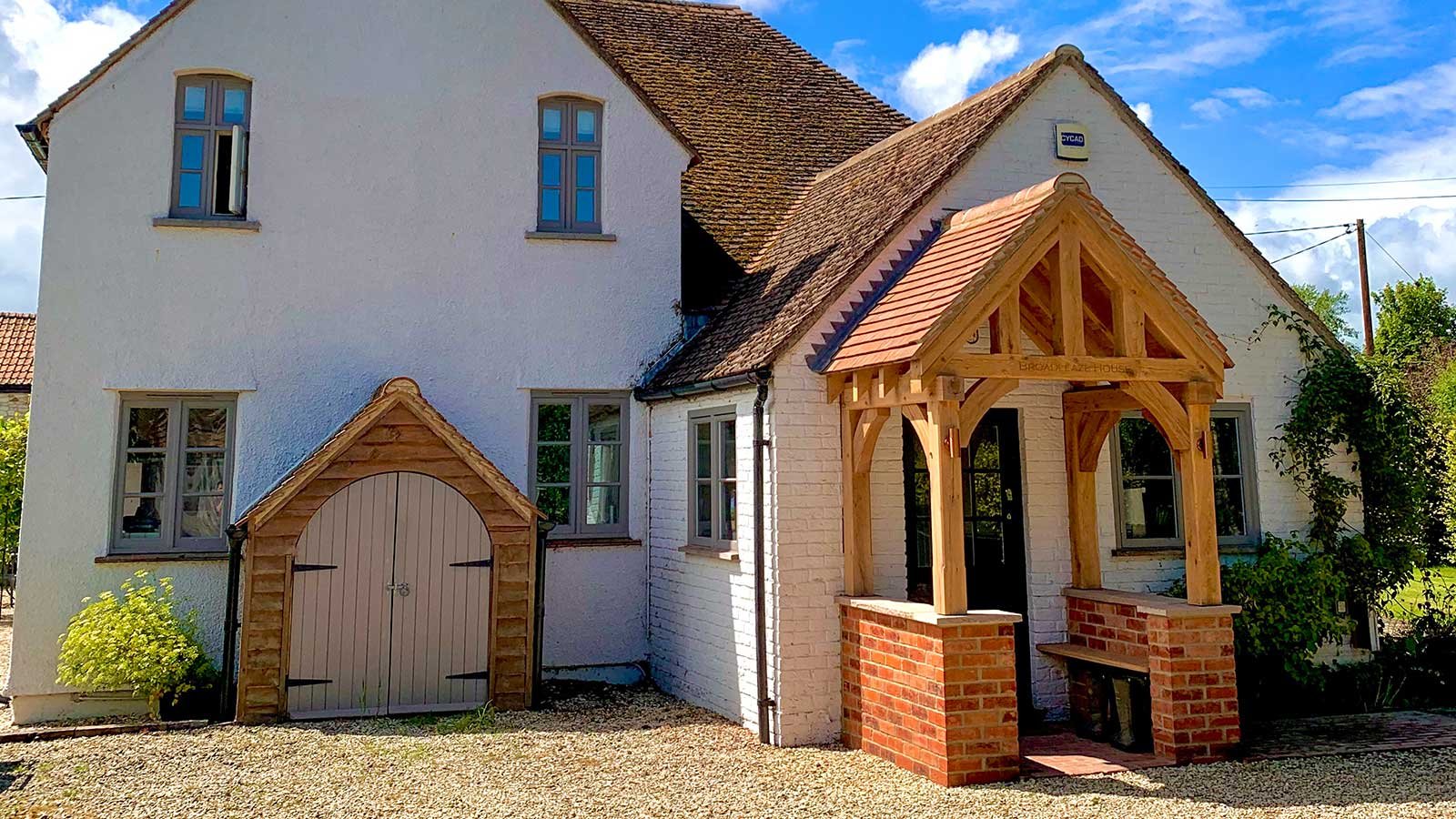
oakbydesign
01423 593 794


Justin contacted Oak by Design with regards to an oak porch with seats, for his period property home on the outskirts of an Oxfordshire market town.
After receiving a quotation though, his house plans changed and he put the porch ‘on hold’.
Nearly 4 years later, in April 2020, he contacted Oak by Design again.
The porch was to fit against a one-storey part of the property with a pitched roof. As the porch was to be on the gable end of the house, the porch needed to have the same pitch, which is 45°, to look aesthetically correct
The porch would lead into the hallway and utility room and then on into the kitchen.
After speaking to Joanne about his options and plans, they agreed with a design.
Justin chose to have curved brackets on the front of the porchand on both sides. This creates a very cosy feel inside the porch and the curved braces create a window effect.
A quotation was sent out with the initial measurements.
Justin had been in contact with his builder, Ben, and they had discussed the installation of foundations for the porch’s brick dwarf walls. Justin decided to incorporate oak seats into the porch on each side for sitting and log storage.
He also chose to have oak boarding on the underside of the porch roof, and his electrician would then be able to use this to hide the wiring of the porch lights.
Justin ordered the open oak porch with a manufacturing start date of early June.
Once Ben had completed the walls for the porch, along with fitting the coping stones, at the end of May, he sent the final measurements to Oak by Design.
Oak By Design provided a drawing of the porch which both Justin and Ben checked and approved.
Justin also chose to have the house name engraved on the tie-beam of the truss and also an owl, in memory of his Godmother, engraved on the back post.
The porch was all sanded and finished with Osmo UV oil
Delivery was made to Justin on 17th June and a couple of days later Ben had installed the porch.
Justin is absolutely thrilled with the porch. Within a few days, he had people asking him where the porch was from!
Within a few days of the porch being finished, Justin was back on the phone with Joanne. This time, he wanted an oak glazed garden room.
Great oaks from little acorns grow….!
If you'd like to read the Case Study for this, it is here
Designing an oak porch presents an opportunity to create a striking and welcoming entrance to your home. This article will explore three design ideas that can inspire your oak porch project: traditional charm, contemporary elegance, and rustic simplicity.
One popular design approach for oak porches is embracing traditional charm. This style pays homage to the timeless appeal of classic architecture by incorporating elements such as intricate timber detailing, decorative brackets, and pitched roofs. The use of handcrafted joinery techniques further enhances the authenticity and craftsmanship of the porch. By opting for a traditionally inspired design, you can create a warm and inviting entrance that exudes character and nostalgia.
For those seeking a more modern aesthetic, a contemporary oak porch design may be the ideal choice. Clean lines, minimalist finishes, and sleek materials characterise this style. Large glass panels or glazing can be incorporated into the design to maximise natural light while maintaining a seamless connection between indoors and outdoors. The juxtaposition of oak against other materials such as glass or metal creates an interesting visual contrast that adds sophistication to your home's entrance.
If you prefer a more understated look that emphasises natural beauty, consider a rustic-inspired design for your oak porch. Exposed beams, textured finishes, and earthy colour palettes contribute to this style's relaxed yet charming atmosphere. By using reclaimed or weathered oak in your porch construction, you can achieve an authentic rustic appearance that blends seamlessly with its surroundings. This design idea is perfect for homeowners who appreciate simplicity and want their porch to blend harmoniously with nature.
Green oak and air-dried oak are two distinct types of timber commonly used in the construction industry. Understanding their characteristics is essential for any building expert.
Green oak, obtained from freshly felled trees, typically contains a high moisture content ranging from 60% to 80%. As the oak undergoes seasoning, a natural drying process, its moisture content gradually decreases. Seasoning can occur through air drying or kiln drying methods. However, in this discussion, we will focus on air-dried oak.
Air-dried oak is cut to size and left outside to dry naturally over time. During this period, proper air circulation between the timbers aids in reducing the moisture content. On average, air-dried oak dries at a rate of approximately 25mm per year. The duration of seasoning for air-dried oak depends on its thickness and can range from three to ten years.
One notable advantage of air-dried oak over green oak is its lower moisture content. This reduced moisture level makes air-dried oak more stable and less prone to movement and shrinkage compared to green oak. Consequently, using air-dried timber in construction projects minimises the risk of warping or cracking due to changes in humidity levels.
Moreover, because green oak contains higher levels of moisture, it may continue to shrink as it dries out after installation into a structure. This ongoing shrinkage can lead to gaps appearing between joints or connections within the building elements.
In summary, while both green oak and air-dried oak have their applications in construction projects, understanding their characteristics is crucial for selecting an appropriate timber type based on factors such as stability and resistance to movement or shrinkage during use.
Telephone: 01423 593 794
Locksley Park
Blind Lane
Tockwith
YORK YO26 7QJ
Opening Times:
Mon to Fri - 9.00am to 5.00pm
Bank Holidays - Closed
Christmas 2025- TBC
Oak By Design is the trading name of:
Oak By Design Ltd.
Reg Number: 04384416
VAT Number: 664 8012 33